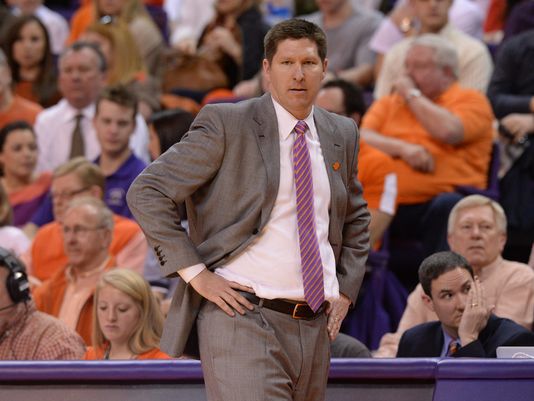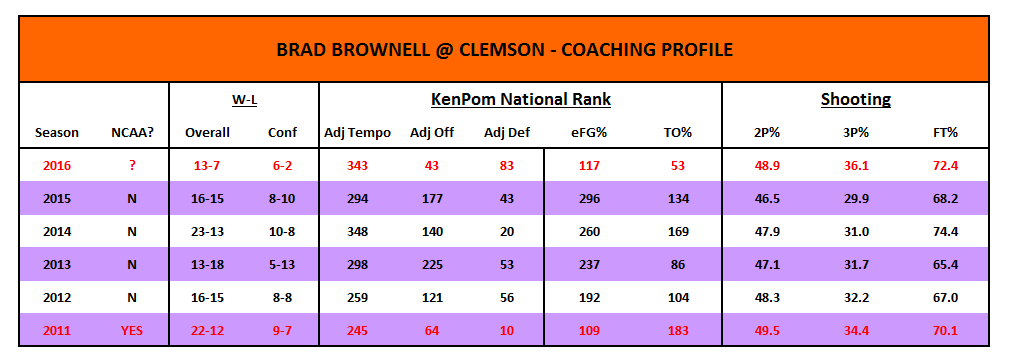Is Clemson For Real?
Posted by Brad Jenkins (@bradjenk) on January 28th, 2016Heading into league play, Clemson was but an afterthought in the ACC. They had not only played one of the weakest non-conference schedules in the nation, but had also performed miserably against it, posting a record of 7-5 with the “marquee” win coming against Texas Southern. But somehow, Brad Brownell’s Tigers have engineered a shocking turnaround in ACC play. Against the toughest league slate faced by any ACC team up to this point, Clemson has won six of its first eight games and currently sits in third place in the league. No other major conference school in the country has seen such a dramatic change in performance. How have the Tigers done it? Can they maintain this level of play? And most importantly, can this Clemson team make the NCAA Tournament for the first time since Brownell’s first season at the school?

Clemson’s Brad Brownell Has An Improved Offense And A Surprisingly Big Home Court Edge In ACC Play. (Bart Boatwright/greenvilleonline.com)
There have been two key improvements that have led to Clemson’s turnaround, one statistical, one more subjective. By looking at Brownell’s coaching profile (table below), we see these Tigers actually have the worst rated defense in his six years at the helm. But that is being more than offset by the most potent offense Brownell has put on the floor during his tenure at Clemson. In a league like this ACC – with seven of the country’s top 27 offenses, you have to be able to score at a high level to compete with the best teams. The Tigers have done just that – ranking fifth in offensive efficiency in ACC games. The two main factors in the improved Clemson offense are turnover percentage and effective field goal percentage, both of which are vastly better this year compared with recent seasons. And after years of struggling from behind the arc, three-point shooting is now a strength of this Tigers’ squad (as seen below).

The other big change in Clemson’s season is the difference in the Tigers’ performance on their home (really away-from-home) court. While Littlejohn Coliseum undergoes a major renovation, Clemson is playing home games this season at Greenville’s Bon Secours Wellness Arena – a 45-minute drive from campus. And while the Tigers went 6-2 in that building against non-conference foes, the two losses came to Alabama and South Carolina – a pair of teams rated lower by KenPom than any of Clemson’s eight ACC opponents so far. However, it’s been a different story in January, with the Tigers winning all five of their league games in Greenville, which included a stretch of three straight over highly ranked teams – Louisville, Duke, and Miami. While none of those wins were blowouts, none came down to the last shot, either – the average margin of victory in the five home triumphs is over eight points. So perhaps Brownell should encourage the Littlejohn construction crew to slow down a bit, because the new home court is working just fine right now.
Looking ahead, a case can be made that the Tigers haven’t necessarily peaked. Going into conference play, Clemson had fallen to 101st in KenPom, but the Tigers are now all the way up to 50th. KenPom currently projects them to finish with a conference record of 12-6, which seems highly achievable when you consider that Boston College shows up twice on the Tigers’ remaining schedule. What’s more, Clemson has a bona fide stud in junior forward Jaron Blossomgame (16.7 ppg, 6.9 rpg) to lean on in the tight ACC games to come. The main concern would have to be Clemson’s ability to win on the road down the stretch. The Tigers have benefited from only playing three road conference games so far, but the only wins they have away from home all year are a neutral floor victory over hapless Rutgers, and an overtime win over Syracuse when Jim Boeheim was suspended.
The NCAA tournament picture is still cloudy for the Tigers. Currently, ESPN’s Joe Lunardi has them as one of the last four in his projected bracket, while CBS’s Jerry Palm does not currently have Clemson in the field. No matter how high they finish in the ACC, Brad Brownell’s team will always be held accountable for that poor showing in the non-conference. In 2014, Clemson was left out of the Big Dance despite an 11-9 record versus ACC teams. The reason for its omission that year was a similarly weak non-league strength of schedule, but that Clemson team at least managed to go 9-3 in the non-conference conference portion of the season. So history might suggest that even a 12-6 ACC regular season mark will not guarantee Clemson a bid, despite all the impressive wins already accumulated. Clemson potentially presents the Selection Committee with quite a dilemma; reward a team for a high finish in one of the two strongest leagues in the country, or punish a team for playing an extremely weak non-conference schedule (325th SOS) and struggling during it. The deciding factor in Clemson’s postseason fate may be the Tigers’ ability to prove themselves away from home. More road wins on the way in – along with a strong performance in the ACC Tournament in Washington, D.C. – may be just what’s needed to put the Tigers on the right side of the bubble on Selection Sunday.










































